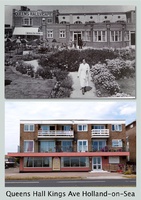
Holland on Sea by Roger Kennell
HOLLAND ON SEA
The roads lined with 20th century houses and bungalows belies a place with an ancient history. The compilers of the 1086 Domesday Book listed Hoilanda, and which was already a settlement in late Saxon times. Also recorded was a manor, and the manor house was on the site of Little Holland Hall. A church was built in the grounds during the 12th century, and soon enlarged, evidence of a growing prosperous village. Prosperity came from agriculture, and trading from the now lost Gunfleet estuary, once at Holland Haven, the name meaning a harbour.
The estuary began to silt up during the 17th century resulting in a loss of prosperity, villagers moved away, and the church abandoned and soon became a ruin. The succeeding centuries saw the village, by now named Little Holland, with a population of well below one hundred persons just about existing and centered around three farms, including the hall (the former manor house) where there was a tenant farmer.
At the end of the 19th century, the then principal landowner from Lowestoft, Suffolk decided to auction off his lands presumably because they were unprofitable. An auction was held in London in the year 1900 of some 95% of the village in 60 lots. At the sale all the lots were purchased by David Cripps-Preston from Dulwich Village, London. Preston then devised four building estates, a road layout, and individual building plots. At a series of auctions then held, these building , shop, and hotel plots were then sold. It was from this point the development of a new community begun, and which after a faltering beginning, began to grow rapidly between the two world wars. The village was also attracting summer holiday visitors and the parish council decided that the village name of Little Holland was by now inappropriate. After a short period when the name Little Holland on Sea was used, being cumbersome, in 1928 it became Holland on Sea.
The growing community required public utilities, places of worship and shops. The provision of these facilities against a difficult world economic background, and a World War was not easy. At the end of the 1950s there were still many undeveloped building plots, unmade roads, including the Kings Parade, and no sea wall along the base of the cliffs. By the end of the century the completion of these had been achieved.
The establishment of Holland on Sea during the 20th century must be one of the most notable centuries of the many centuries since the name of Hoilanda was recorded during the 11th century.








